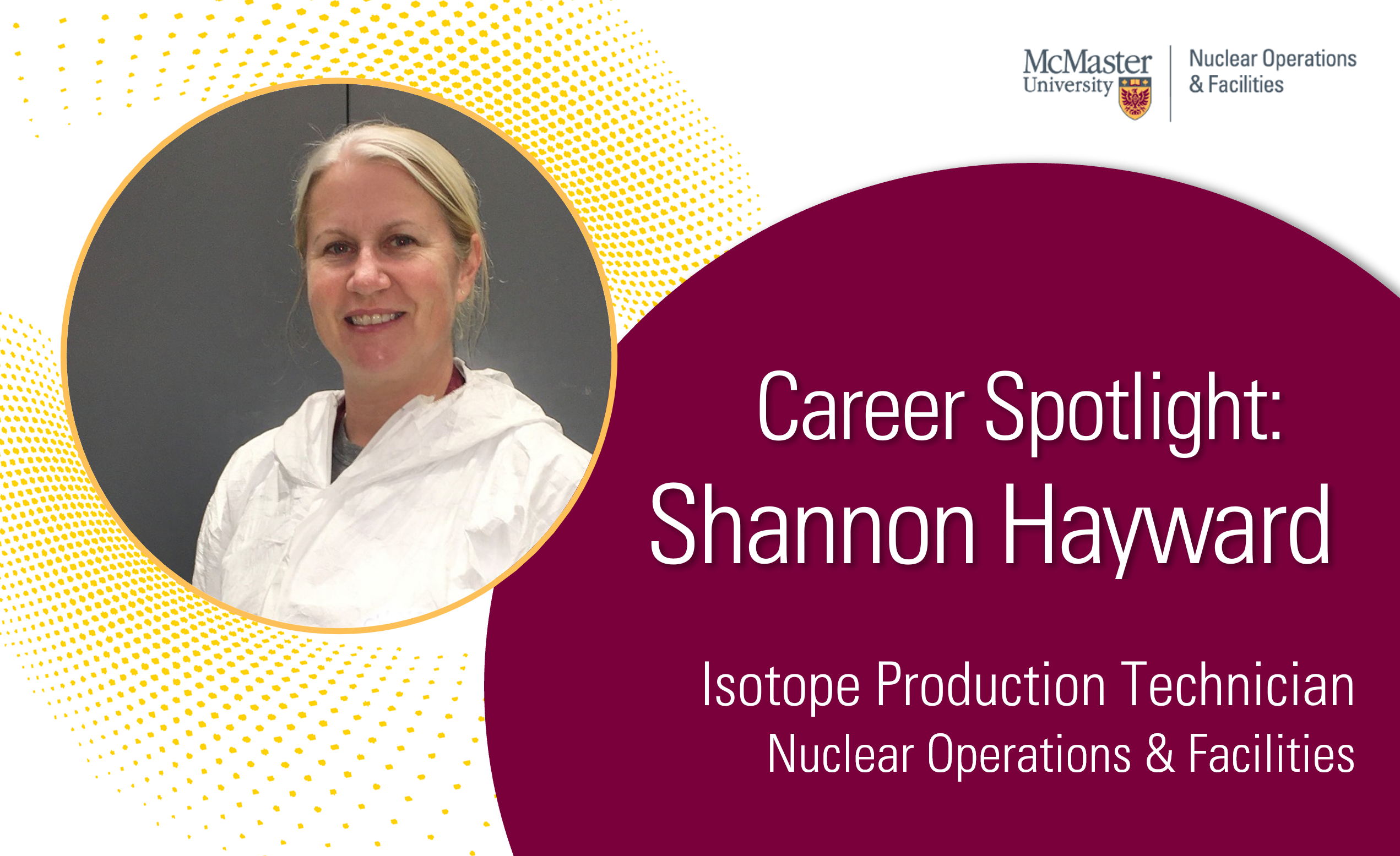Career Spotlight: Shannon Hayward

Shannon Hayward is an isotope production technician at Nuclear Operations & Facilities (NO&F), where she makes iodine-125 (I-125) – a medical isotope produced at the McMaster Nuclear Reactor (MNR) and used to treat thousands of cancer patients around the world every year. In the interview below, Shannon guides us through the I-125 production process and shares how her passion for animals and veterinary medicine informed her career path.
What is your role at Nuclear Operations & Facilities?
I’m an isotope production technician at NO&F. I work with our isotope production team to produce radioactive isotopes that are used in research and medicine. As an iodine production technician, our roles on any given week include, but are not limited to: preparing our custom-made rigs for irradiation, retrieving product from the rigs, performing quality control on our product, and finally dispensing the product and preparing it for shipment.
What is iodine-125 and how is it made?
Iodine-125 is one of the medical isotopes we produce at McMaster. I-125 is a radioactive version of the chemical element iodine. I-125 is produced by irradiating enriched xenon-124 gas inside of the McMaster Nuclear Reactor core. The gas is exposed to neutrons, and through a process called neutron capture, xenon-124 turns into xenon-125, which then decays into the desired product, I-125.
Once this process is complete, we retrieve the I-125 from the rig and begin quality control on the product. We measure the purity of the I-125 to make sure it’s in the right chemical form, and that there are no radioactive impurities in it. The product is then dispensed into glass vials, which are carefully packaged for shipment to our customers.
I-125 has a 60-day half-life, which is quite long compared to other medical isotopes. We account for decay of the product in the shipping process by making more than requested and sending it out quickly, usually within a week or two after it’s been made.
What is iodine-125 used for?
We ship I-125 to countries all over the world for use in cancer treatments and medical research. Primarily, McMaster’s I-125 is used in brachytherapy for prostate cancer. Brachytherapy seeds containing our I-125 are implanted near the tumour, providing a localized form of radiation therapy.
What kinds of personal protective equipment (PPE) do isotope production technicians wear while working?
That depends on what job we’re doing. Some jobs require us to be in full protective equipment, which would include a Tyvek suit and multiple layers of gloves and sleeves. Oftentimes we are working with high amounts of I-125, which is quite volatile, so we wear a breathable air hood to prevent us from inhaling radioactivity. Some jobs can be performed wearing only a lab coat and gloves, such as when we are performing quality control tests in a fume hood.
What kinds of skills are essential for your job?
Isotope production technicians work with their hands a lot, so dexterity is important. Attention to detail is also very important. There are stringent workflow and safety protocols, and we work closely with McMaster’s Health Physics department to make sure our work practices are safe. Communication and openness also help with safety; it’s important to be honest and communicate if something doesn’t seem right or if you’re unsure about a procedure.
What did you study in college, and where did you work prior to NO&F?
I went to St. Lawrence college in Kingston, Ontario where I completed a three-year Veterinary Technology program. The program was half research-based and half clinic-based. I’ve always loved animals, and I originally thought about working in a vet clinic, but I discovered that I really enjoyed the research side of things. I worked as a surgical technician in a cardiovascular lab at Queen’s for a couple of years and then moved to McMaster, where I began research work with Dr. John Valliant and Dr. Gurmit Singh. This collaboration helped us understand the uptake and distribution of cancer targeting radiolabelled compounds in various cancer cells and animal systems. This research was important for the advancement of medical imaging and radiotherapy. I worked at McMaster University in the department of Chemistry and Chemical Biology for 10 years before moving to MNR.
Can you share a memorable experience or achievement from your time working at NO&F?
McMaster’s Medical Isotope Supply Chain team was given a President’s Award for Outstanding Service in 2020. We worked throughout the pandemic to continue supplying the world with essential isotopes. McMaster supplies about half of the world’s iodine-125, so our production team really couldn’t slow down when the pandemic began. Because there were only five of us, our biggest concern was that several of us would contract COVID-19. If this happened, production would need to be put on hold for at least two weeks. We split ourselves up into two teams and worked alternate shifts to prevent this from happening, which meant we had a lot more work to do in our small groups. It was challenging, but we got through it!
What do you enjoy most about your job?
I think everyone in the isotope production team enjoys being able to see a process unfold from the start right to the very end. We know that our product is going to be used to treat cancer; we know that our work is helping people. The other thing that I love about my job is the people I work with. Our isotope production team is like a family. We get along incredibly well, and we know we can rely on each other to ensure we are doing our jobs safely.
Blog